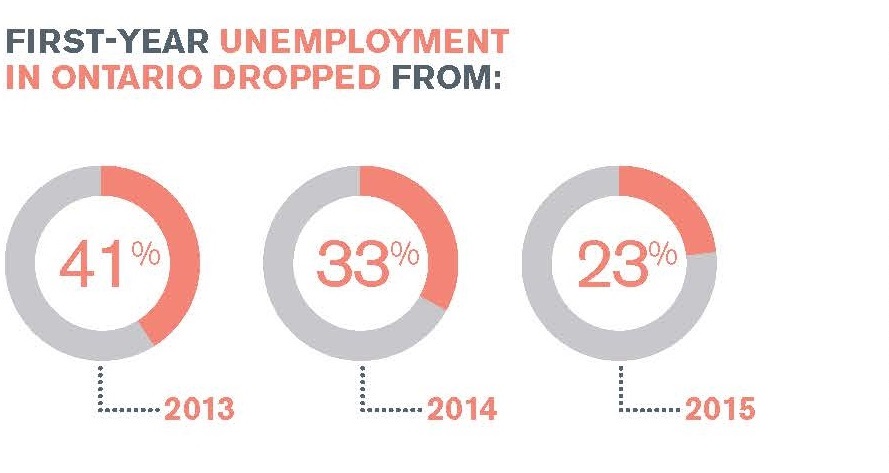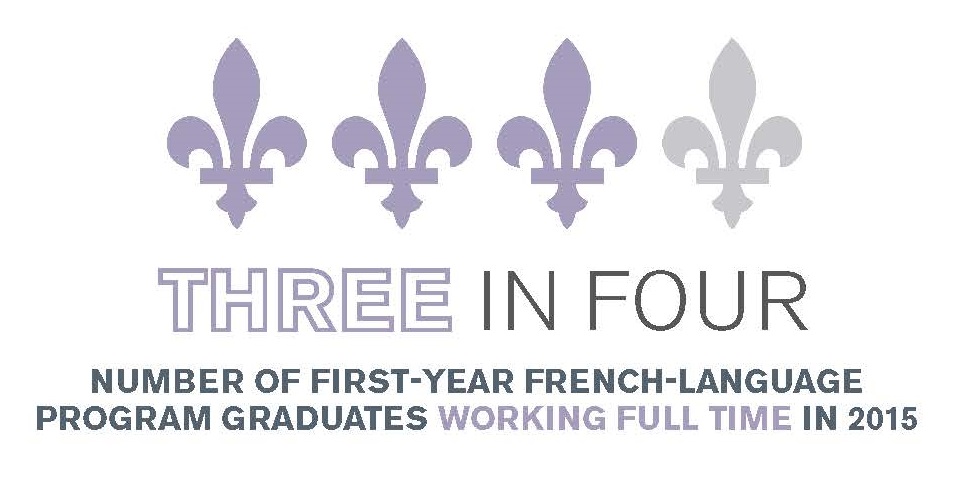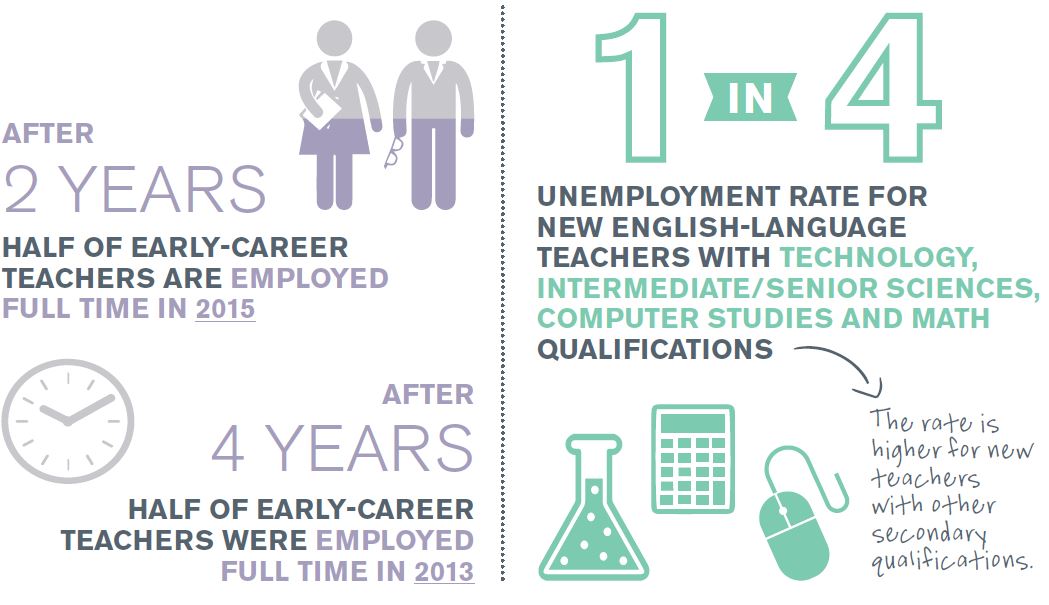Share this page
By Frank McIntyre
Infographics: Hannah Browne/Studio 141



The findings of the College’s 2015 report on Ontario’s teacher job market is welcome news for future Ontario teachers. The latest Transition to Teaching survey, which polls newly licensed graduates of the province’s teacher education programs,
found that first-year teacher unemployment in Ontario is on a steep downward trend — from 41 per cent in 2013, to 33 per cent in 2014, and dropping to 23 per cent in 2015.
The job outlook is especially good for French as a Second Language (FSL)
teachers, who report just three per cent unemployment — a sharp decline from 17 per cent of FSL teachers in 2013 unable to find teaching jobs in their first year. And teachers who graduated from French-language programs at Laurentian and Ottawa universities saw their Ontario unemployment rate drop from 15 per cent in 2013 to just four per cent in 2015. The five-year-long surplus of FSL teachers and teachers qualified for the province’s French-language school boards is finally over.
Newly licensed English-language teachers also experienced more welcoming job markets across the province. Ontario-resident unemployment rates continue to drop from the peak level reached in 2013. Although many Ontario English-language graduates licensed in 2014 told us they could find no teaching positions in their first school year, the 31 per cent unemployment rate for these teachers is much improved from 45 per cent back in 2013. Despite this good news, the legacy of years of teacher oversupply still leaves many of the province’s English-language teachers underemployed for their first few years of teaching.
Job gains in 2015 were broad based; graduates across all divisional qualifications now report unemployment rates of one in four or lower — well below comparable first-year rates two years ago. And although some regions of the province experience higher unemployment rates than others, no region was above 30 per cent unemployment in 2015.
Survey responses in 2015 from teachers certified two to five years prior reinforce the improving prospects for Ontario’s education graduates. Three years ago, our surveys found that it took four years for half of early-career teachers to reach full-time employment. Now, 50 per cent are fully employed just two years into the profession.
Employment market changes over the past two years are mainly a result of lowered new teacher job competition. From 2012 to 2014, there were about 2,100 fewer newly licensed teachers annually than in the preceding four-year period. In addition, more early-career teachers are allowing their College membership to lapse — at least temporarily — taking themselves out of the Ontario teacher job market. The five-year loss rate in 2015 was one in every six new teachers (16.3 per cent), up from less than one in 10 (9.5 per cent) back in 2005. And for French-language teachers, more than one in five (22.3 per cent) drop their College membership within five years of certification.


“Although the rate of the job market change for some qualifications will outpace others, the shift in the teacher supply and demand balance means most new teachers will find full time employment faster.”
Ontario’s Enhanced Teacher Education Program, introduced in 2015, will have a substantial impact on new teacher job competition in 2016 and in following years. Applications to consecutive teacher education programs in 2015 dropped to less than half in previous years; admissions to teacher education fell even further as part of the planned move from two to four semesters of education degree requirements. These teacher education intake cuts — combined with fewer new teachers from out of province — will result in historic low numbers of newly licensed Ontario teachers in 2016 and volumes in following years that are below half of recent annual levels.
Teacher retirements are forecast at approximately 4,500 annually through the end of this decade. With steady levels of annual retirements and a greatly reduced new teacher supply, Ontario’s teacher employment market is about to experience a tectonic shift. From 2008 to 2011, there were 7,700 more new teachers licensed each year than there were annual teacher retirements. This created a large teacher surplus, high job competition and steadily rising early-career unemployment. The modest reduction of this excess to around 5,100 annually from 2012 to 2014 lowered job competition and resulted in much lower unemployment rates.
From 2016 to 2018, the excess of new teachers that we have seen in recent years will move in the opposite direction; rather, we will see a small shortfall of new teachers in relation to retirements. Based on job trends identified in recent surveys, we can expect more substantial declines in unemployment in future years as more teachers find full-time employment much earlier in their careers. This decrease in new teacher intake will provide job opportunities for many of the still underemployed surplus teachers from prior years, who will finally obtain full-time teaching jobs.
New French-language teachers in the years ahead should reap the benefits of a seller’s market. Very few of them will be looking for jobs during the 2016–17 teacher recruitment cycle, and about half of the most recent numbers will be on the market in the following two years. With French-language program graduates and FSL teachers in 2015 already experiencing minimal unemployment in their first year, and with three in four of them fully employed, the next few years will likely be marked by strong competition among Ontario school boards to fill French-language teaching positions.
Job markets for French-language program graduates and FSL teachers overlap somewhat in Ontario. The 2015 survey shows that one in four first-year teachers coming out of our French-language programs complete an additional qualification in French as a Second Language, and one in six of them in Ontario are employed by an English-language school board. With FSL teachers already in very high demand in 2015, both English-language and French-language board recruitment of French-language teachers will be considerably more challenging.
Our 2015 survey also found English-language technological education and intermediate/senior sciences, computer studies and math to be specialties with already rising demand relative to supply. Ontario first-year unemployment rates are below one in four for teachers with these specializations, considerably lower than for new teachers with other secondary qualifications. These markets may also shift to high demand quite rapidly with the drop in new teacher numbers over the next few years.
The Transition to Teaching study findings hold much promise for future entrants to teaching in Ontario. Although the rate of the job market change for some qualifications will outpace others, the shift in the teacher supply and demand balance means most new teachers will find full-time employment faster. With unemployment rates for first-year teachers on a steep decline, we can also expect more vigorous and competitive teacher recruitment for Ontario’s school boards over the next few years.
In 2015, many previous graduates of Ontario faculties of education who had not become College members decided to obtain their teaching licences prior to the implementation of the two-year Enhanced Teacher Education Program. This one-year bump in new members may not moderate job market trends; many of these individuals who already deferred teaching careers may not be planning immediate entry into the profession.
Legislation introduced in the fall of 2012 supports transparency in hiring by Ontario publicly funded school boards. Standardized procedures define a pathway to permanent employment that normally requires new teachers to start with daily and short-term occasional teaching, then apply for longer-term occasional assignments, and eventually compete for permanent employment opportunities with a board. As employment opportunities continue to improve for early-career teachers, this staged progress toward full-time employment is expected to continue for many new Ontario teachers. The legislation does not apply to Ontario independent school hiring processes.
The Transition to Teaching 2015 survey of new teachers examines job-entry and professional experiences of teacher education graduates from 2005 through 2014, and new-to-Ontario teachers educated elsewhere and Ontario-certified in 2013 and 2014. Web-based surveys were used with large samples from each of these groups of early-career teachers. Responses were received from 3,850 teachers. Response rates varied from 14 to 26 per cent of the samples, with an average 19 per cent return overall. The accuracy rate is 1.6 per cent overall and three to 5.7 per cent for the individual survey components, 19 times out of 20. The Transition to Teaching study is made possible by a grant from the Ontario Ministry of Education. This report does not necessarily reflect the policies, views and requirements of the Ministry. The full report of this year’s study is available at oct-oeeo.ca/1Qn5xMn.